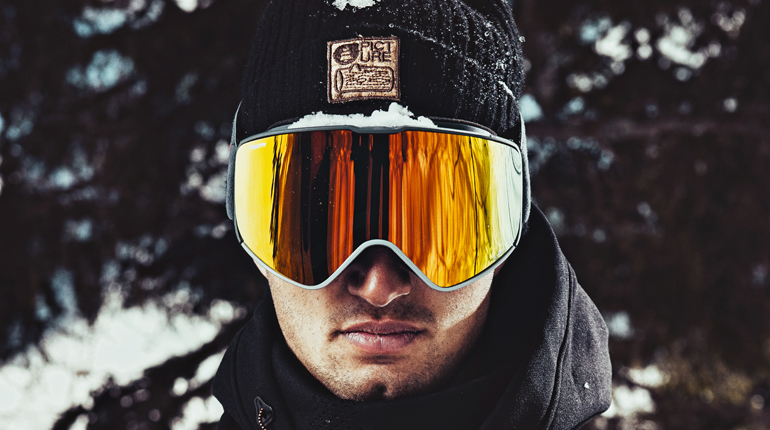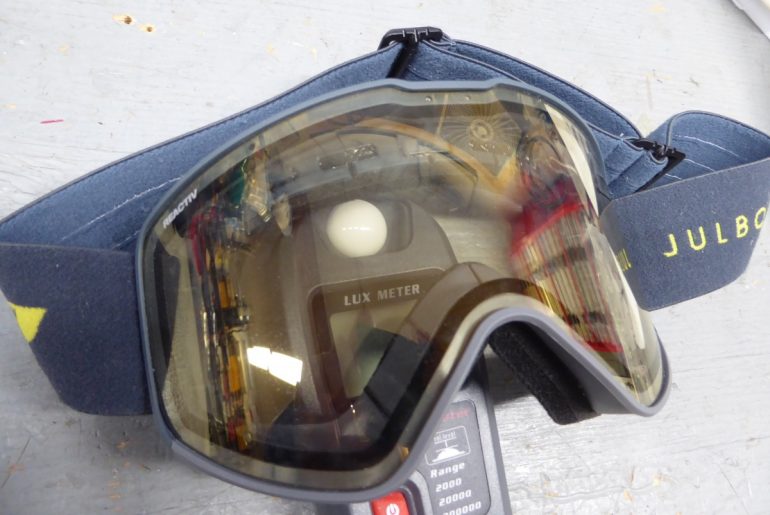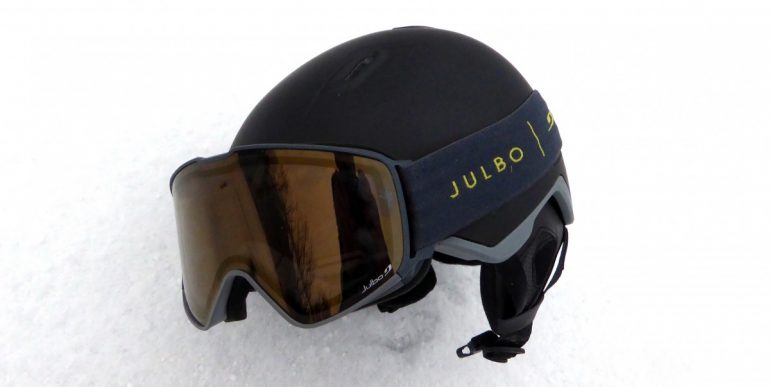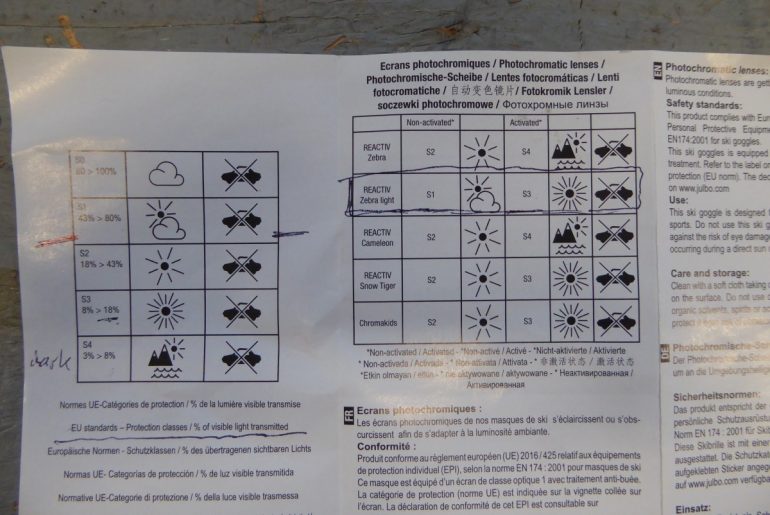
Julbo Cyrius goggles, Emmanu Bournot caught this shot of me* between epics, sorry girls I’m already taken. Only the best for Julbo.
Ok, the MSRP on the Julbo Cyrius goggle is only $219.95 — thought I’d try and sneak some click bait past M. In any case, I’ve probably owned and used more than 200 pairs of goggles over my span, most I paid for. While some, like this pair of Julbo Cyrius, came as product samples. Julbos… anyone who does mountain sports knows Julbo eyewear is nice — in some ways incredible. But I’m not sure I’d ever spend more than $200 on goggles. Would they be worth the money to you? Check out my take, and let me know in the comments.
First position in my “Gogg’ features must-have” list is the lenses. They need to be flexible, double, and (if not photoreactive) tinted in such as way as to be useful for both cloudy days and blue sky. I’ve found plenty of such candidates in my day, as that range of sunlight intensity is not tough to accommodate. Where it gets tricky is my need for something that handles dim light, even night, when I don’t want to carry a second goggle or a second lens. Such use ranges from nighttime headlamp and snowmobile illumination, to days with clouds so thick they cause an artificial dusk. Enter the Julbo, with their photogreactive-Photochromatic-reactive lens. (Yes, they use every one of those words to describe my testers, so in the interest of clarity, and in my ignorance of their proper terminology, I used all).
The minimal documentation enclosed with my pair of Cyrius explains a loosely defined “EU” “S” system of rating goggle lenses by the percentage of transmitted visible light. By way of examples (roughly averaged), an extremely dark goggle suitable for high altitude mountaineering might be rated S4, and transmit only 6% (3%-to-8%) of visible light. The next lighter step from that would be an S3, transmitting a median of 13 % (8%-to-18%) of visible light. S0 would transmit about 90% of visible light. (The S ratings have rather wide ranges, see chart at bottom of this post). See more about these ratings at bottom of this post.
In the case of Julbo’s photoreactive lenses, they rate them with two S-numbers, one for the dark mode, one for light. Julbo’s super-dark yet photoreactive Zebra lens goes from S2 to S4, which at it’s lightest tint these would still filter a significant amount of visible light, thus being useless for anything but fairly bright days.
In my case, I’d asked them to send something that “gets pretty much clear at night.” So they sent a Cyrius frame with a Zebra Light lens that goes from a bright mode of S1, ostensibly letting in around 60% of visible light, to a dark mode of S3 that blocks all but about 13% of visible light. I’ve been field testing these and they’re perfect for me. Dark enough for a blue-sky day at typical Colorado ski touring altitudes, with the non-activated tint being light enough for occasional night use and overcast (though I’d still bring 100% clear goggles for extended night use).
This being WildSnow dot com, I did some measurements to determine how my Julbos did with artificial light. Idea being to simulate night use, snowmobiling or skiing with a bright headlamp. My studio light source measured 360 Lux, attenuated by the Zebra Light Lens it measured 226 Lux. That means the goggles were transmitting 63% of visible light (if I did my percentages math correctly). That’s near the S1 median, which is 61%. I’d prefer that number was more towards the S1 light transmission max, which is 80%, but again, I tested and they do work for me at night. (A possible point of confusion, note Julbo also has a “Zebra” lens, named without the “Light” moniker, that goes form S2 to S4, see chart below.)

Measuring the tint with my Lux meter, under artificial light that is presumably UV free and thus did not activate the photoreactive tint.
Enough nattering about numbers for you? Operative take: Zebra Light is the most useful photoreactive goggle lens I’ve ever tested. Fast reaction (about 30 seconds), excellent percentages. And a nice neutral grey tint to top it all off.
Continuing on with the lenses, a few bullet points:
– Tint change happens in about 25 seconds, any temperature.
– Anti-fog coating on inside of lens is effective, Julbo recommends washing with anti-grease dish soap to keep it working.
– The lens is double, of course. Essential to prevent fogging.
– 100% protection from A,B and C UV.
– Bezel outlining the lens is minimal, for the best peripheral vision possible. Likewise, the boasts the classic “race” shape that drops under the eyes. The only type of frame I’ll use.
– Left to right frame size is big, wrapping nicely behind the eyes, again enhancing peripheral.

Julbo Cyrius, in one of many lens tints, in their photoreactive “Activ” version.
A few things about the frame: Julbo calls the shape of frame/lens “cylindrical.” Near as I can tell that means nothing more than these goggles are not flat as a board, but instead curve around your face. Don’t all goggles do that? (Seriously, curved frames/lenses don’t fit in your backpack as easily as flatter flavors, but I prefer them). The frames are soft, they feel comfortable in the hand and friendly on the cabeza, easily conforming to my head shape, compatible with carrying in a backpack. Venting is the usual microporus foam, time proven keep snow out during all but hurricane force winds or 100 mph runs down Kitzbuhel streif. I like the strap, beefy, no gaudy colors, silicon friction bands to keep it where you want it on your helmet. The strap buckle does not part. That’s a feature I like, but helmet-less guys and girls babying their expensive hairdos might differ with my take. Or perhaps you wear a helmet. In that case all bets are off. For your hair, and whether you need an operable buckle or not.
Speaking of helmets, Julbo also sent me a copy of their “first ever U.S. distributed ski helmet.” The model name is “Hal,” and it looks quite nice. I’ll review it if I like it.

New for the U.S., Julbo Hal helmet, pictured with the Cyrius goggles of this review. One wonders if the helmet is as unruly as its eponymous computer.
Conclusion: Yes, pricey. Julbo’s photoreactive value proposition is no exaggeration. I love the wide, classic shape of the frame. Perhaps most importantly, I have a pair of previous Julbo goggles, but the frame is too stiff for packing in a pack, and somewhat uncomfortable on the face. Cyrius are plenty flexible. Oh, and I almost forgot, the included soft case is the type with built-in protective stiffener, a winner as well. So far this winter these have been my go-to goggs, and not just during apres’ in Aspen. Though a gal with enormous diamond earrings did ask, “Where did you get those fine looking goggles?”
(* Joking of course, the Bournot shot is of my good friend Aurelien Collet.)
Check out some of our other goggle content.
Shop for Julbo goggles.
WildSnow.com publisher emeritus and founder Lou (Louis Dawson) has a 50+ years career in climbing, backcountry skiing and ski mountaineering. He was the first person in history to ski down all 54 Colorado 14,000-foot peaks, has authored numerous books about about backcountry skiing, and has skied from the summit of Denali in Alaska, North America’s highest mountain.

